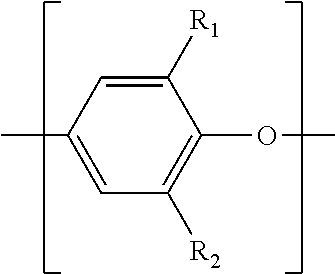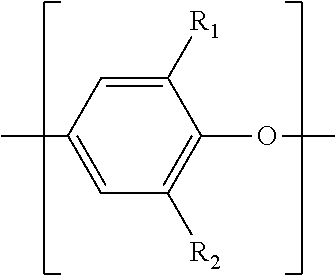Ferroelectric Capacitor With Improved Fatigue and Breakdown Properties
a ferroelectric capacitor and fatigue-reducing technology, applied in the field of ferroelectric materials, can solve the problems of low relative speed in comparison to dram or sram, low durability of rom, and inability to write rewritten rom, etc., and achieve the effect of improving durability and poor durability of ferroelectric capacitors
- Summary
- Abstract
- Description
- Claims
- Application Information
AI Technical Summary
Benefits of technology
Problems solved by technology
Method used
Image
Examples
example 1
Hysteresis (Polarization Versus Electric Field) of Non-Volatile Ferroelectric Memory Capacitors Using Blend Thin Films of Ferroelectric Polymer P(VDF-TrFE) and Polyphenylene Ether
[0087]The concentration of the polyphenylene ether for the ferroelectric capacitors was varied from 0 to 8 wt %. With increasing wt % of the polyphenylene ether the polarization steadily decreases and the coercive field increases but still shows a typical hysteresis loop (see FIG. 4). Even with concentrations up to 8 wt % polyphenylene ether, there are two distinguishable polarization states (+Pr and −Pr) needed for memory applications. The thin films were spun from the solution by spin coating at 4000 rpm for 60 seconds. The films were then annealed on a hotplate for 30 minutes at 80° C. prior to annealing in a vacuum furnace at 135° C. for 4 hours to improve the crystallinity. Finally, the upper gold electrode was thermally evaporated through a shadow mask.
example 2
Fatigue Characteristics of Blend Films with 0 to 6 Wt % Polyphenylene Ether Content
[0088]The fatigue test was carried out at 100 Hz with an applied field of 100 MV / m. The plot shows the total switching polarization (P*) versus cumulative cycles for the ferroelectric capacitor. With increasing polyphenylene ether content the fatigue improves. Pure P(VDF-TrFE) ferroelectric capacitors show 52% retention of polarization after 106 cycles but it improves up to 90% upon using 6% polyphenylene ether (see FIG. 5).
example 3
Fatigue Characteristics of Blend Films with 0 to 6 Wt % Polyphenylene Ether Content
[0089]The fatigue test was carried out at 100 Hz with an applied field of 100 MV / m. The plot shows the total non-switching polarization (PA) versus cumulative cycles (see FIG. 6). The increase in non-switching polarization with number of cycles is due to injection of charges from electrodes which are subsequently trapped at crystallite boundaries and defects, inhibiting ferroelectric switching. Upon adding polyphenylene ether, the devices show lower rise in this non-switching polarization with number of cycles. Thus this leads to the better fatigue performance of our blend films.
PUM
| Property | Measurement | Unit |
|---|---|---|
| Fraction | aaaaa | aaaaa |
| Fraction | aaaaa | aaaaa |
| Fraction | aaaaa | aaaaa |
Abstract
Description
Claims
Application Information
 Login to View More
Login to View More - R&D
- Intellectual Property
- Life Sciences
- Materials
- Tech Scout
- Unparalleled Data Quality
- Higher Quality Content
- 60% Fewer Hallucinations
Browse by: Latest US Patents, China's latest patents, Technical Efficacy Thesaurus, Application Domain, Technology Topic, Popular Technical Reports.
© 2025 PatSnap. All rights reserved.Legal|Privacy policy|Modern Slavery Act Transparency Statement|Sitemap|About US| Contact US: help@patsnap.com



